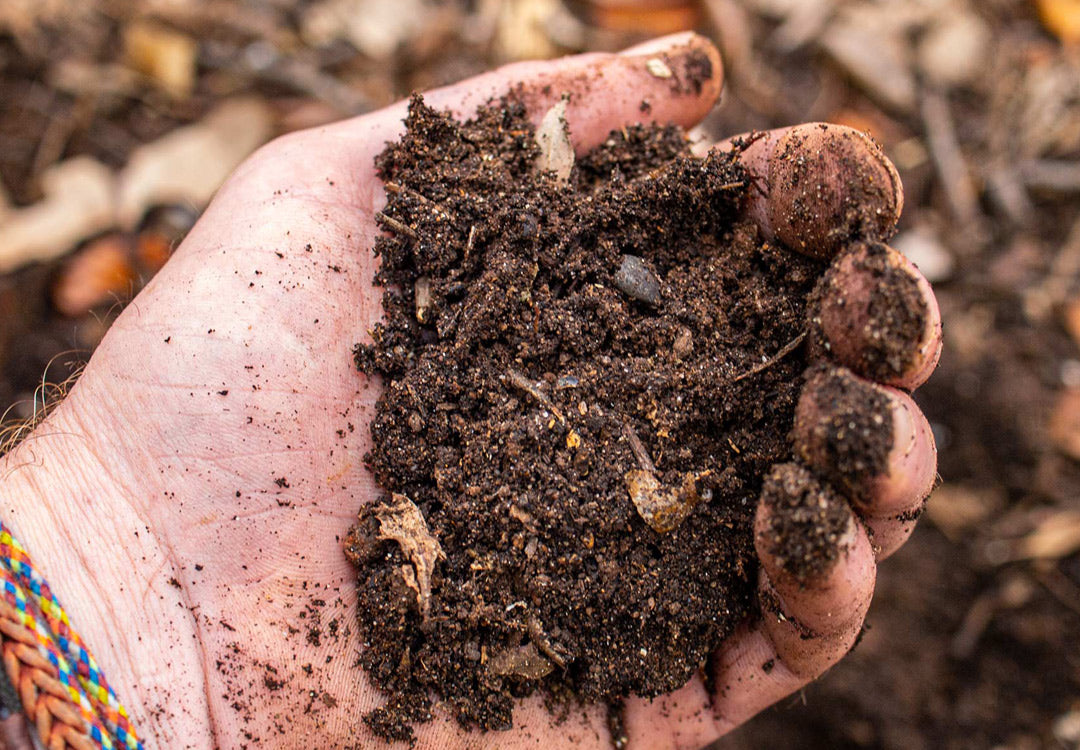
Healthy plants start with healthy soil, which is something we tend to forget when setting up a new garden or maintaining our existing gardens. We can hardly be blamed; it’s the beautiful plants that we are really interested in, not the boring brown dirt. But the best gardeners will tell you to “feed the soil and the soil feeds the plants”.
Good soil will be a dark colour which indicates organic material and plenty of minerals. You’ll be able to see a lot of worms in the best quality soil. Most plants love a soil with plenty of organic material and good structure that drains well but holds moisture.
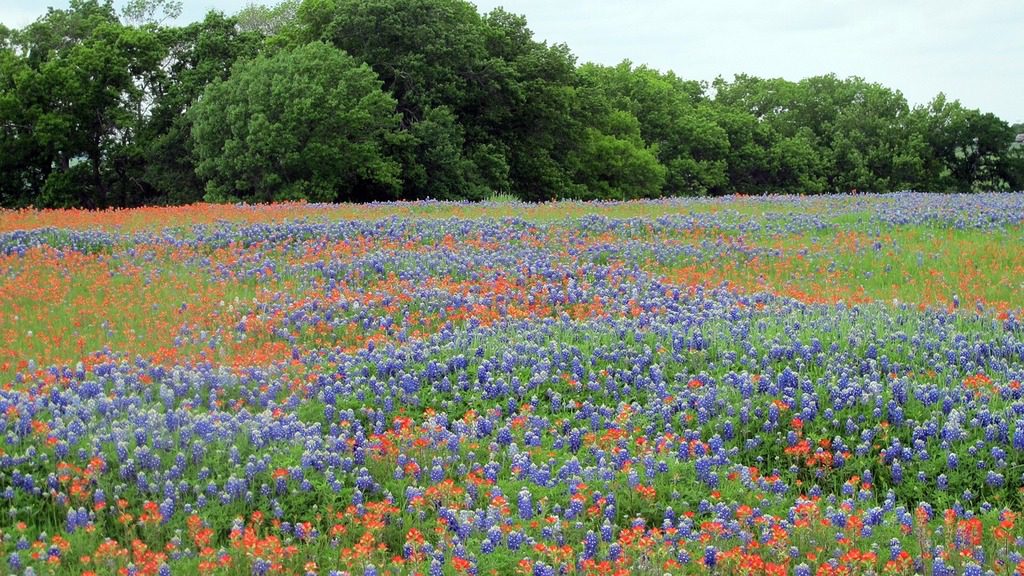
A lot of healthy-looking plants can indicate a decent level of soil health. Image source
In nature, plants don’t usually stand alone without any help from microscopic critters, fungal mycelium or other plants. They are very social and even allow themselves to be colonised by an ecosystem which can break down nutrients and deliver them in a form the plant can use.
When we provide water-soluble nutrients in the form of chemical fertilizers, the plant can absorb the nutrients directly and does not need to allow itself to be colonised and so can become reliant on the chemicals.
This is a shame because these beneficial microbes can fight off pests and pathogens, so a chemical fertiliser reliant plant is likely to become weakened and pesticide reliant over time in a downward spiral.
All plants have their own needs: some prefer sandy soil, and some prefer clay, some like it dry and some like it wet. But in general, a soil that balances water retention with drainage, while having a lot of organic material and biotic activity going on is the best sort of soil.
What Is Soil Made Of?
Soil particles can be distinguished into three types based on their particle sizes:
-
Clay particles are super-fine and tend to bind together and prevent the movement of water and nutrients. When clay becomes waterlogged it deprives plant roots of oxygen. When dry it can become quite hard, potentially leading to root binding and making it hard to dig into. You may also see cracks on the soil surface. When wet, it feels clumpy and slimy and holds its shape perfectly just like potter’s clay. If you can roll a ball of soil out into a noodle, it’s clay-dominant.
-
Sand particles are much larger and allow water and nutrients to pass straight through, so you may lose a lot of your water and nutrients in sand-dominant soil causing your plants to suffer unless they can tolerate drought conditions. It feels gritty in your hands and doesn’t hold its shape very well, thus the roots of plants find it hard to get a grip. If the soil is too crumbly to hold a ball (let alone a noodle) it’s probably sand-dominant.
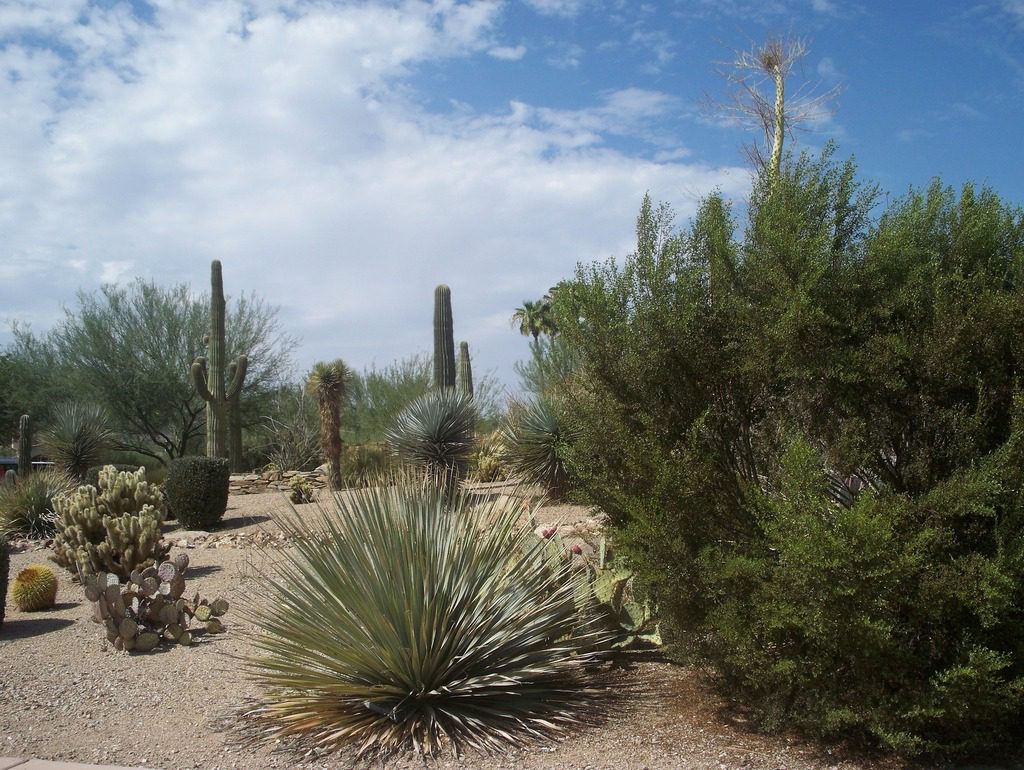
Arid plants in a sandy garden that is similar to their natural desert environment. Image source
-
Silt feels soft to the touch and has molecules sized somewhere between sand and clay. Silt residue can come from topsoil that has washed away from elsewhere, indicating issues with soil health and erosion. When it’s healthy it can help make good soil though it is easily compacted.
These three soil particle sizes rarely exist on their own, and usually exist in some sort of combination with each other. The soil triangle is a good tool we can use to define the soil mixture we are dealing with.

The soil textural triangle helps classify the aggregate of clay, sand and silt separates. Image source
Within this mixture of the three soil particles (also called soil “separates”) exist a range of other factors, including:
-
Decomposing organic material which beneficial microbes are breaking down so that the nutrients are unlocked for plants to consume. Compost contains a broad spectrum of nutrients plants need as well as carbon, which plants store in their bodies as a result of photosynthesis. This makes it the perfect home to many beneficial organisms that plants form beneficial relationships with.
-
Humus is the term for organic material that’s pretty much totally decomposed and no longer contains significant nutritional value; it’s dark brown and has a crumbly texture that makes it easy for roots and earthworms to wriggle around. Even without nutritional content, humus is highly beneficial for soil structure and can store water like a sponge without making the soil soggy.
-
Uncomposted organic matter may come in the form of leaves and sticks beneath the surface of the soil that have not yet begun to decompose. Peat is one example of uncomposted organic material; it feels spongy and naturally comes from areas with highly acidic soil and poor drainage. Reduced decomposition means that there are high amounts of organic material, but low levels of nutrients that are available to plants.
-
Living organisms makes up a huge amount of what makes up the soil. In fact, it’s said that good soil in the rhizosphere (the upper part of soil that contains plant roots and associated micro-organisms) is made up of as much as 30% fungal mycelium. Life forms are integral to building and maintaining soil structure; for example as insects move about, they create tunnels and pockets that air and water can filtrate through and plants can grow roots more easily. Other organisms like bacteria are crucial to breaking down organic matter and making nutrients available to plants.
-
Minerals are present within the soil in many forms; rocks are basically just large deposits of them. Some of the minerals in soil include nitrogen, phosphorous, potassium, iron, manganese, and the list goes on.
-
Water is held in soil “pores”, which are the spaces between the particles. Because clay particles are small, they plug more of the pores than sand particles do and so may block the movement of this water more than sand particles do. Too much water can kill most plants which require air within the soil pores as well as moisture. We want our soil to generally stay somewhere between bone dry and completely saturated most of the time, because in general neither state is desirable for healthy plants for long. Read more about the water needs of plants through this post I wrote.
-
Air is an ingredient within the soil, even if we don’t think of it that way. It’s within pores in the soil and believe it or not, plants actually breathe oxygen within this air through their roots.
We can identify the different soil textures available in any garden, lawn or nature strip around the world by scraping a bit of the topsoil and making a ball to roll in our hands. Feel and look at the textures can be discerned. Which separate/s are dominant?
Too much clay and the water can’t pass through. Too much sand or silt and the water passes straight through without giving our plants a chance to drink it.
We generally want a good mix of sand, silt and clay along with our composted biological material, as too much of any one particle type can cause issues. Sandy loam is often considered to be the best soil type for most plants.
With that being said, different plants do prefer different soil types. For example, succulents generally love sand soil and don’t do well if the soil holds too much water.
The most accurate way to test our soil texture is through a professional soil testing laboratory, though we can also use a home testing kit to compare with our own analysis from feeling it in cases where we don’t need to be absolutely accurate.
Adding compost or other organic fertilisers to poor soil of all types will usually help balance out the existing soil, whether that be water drainage or retention. Sometimes we may also need to use clay breaking liquids or gypsum sand on heavy clay soil to break it apart.
Soil Profile
If you’ve ever driven along a motorway for any length, you’ve probably seen parts where the road cuts through a hill and you can see a cross-section of different layers and types of soil that have been formed over unimaginable spans of time.
What you’re looking at is a soil profile, which is a vertical section of the soil showing the different layers of soil beneath the surface. If you dig into the soil in your own garden you’ll notice the same thing happening. Depending on the soil present, you may have to dig a fair way until you notice a different type of soil, but it’s still a profile if only one soil type is present.
With a post shovel you can dig 60cm deep for a shallow profile, or have somebody trained in using heavy machinery like a backhoe to dig deeper for you.
Topsoil
The topsoil is the name for the top layer of soil within the soil profile where most of the organic matter, nutrients and roots are. The deeper and darker your topsoil, the better because organic material darkens the colour.
Subsoil
This is the layer of soil directly beneath the topsoil. It’s generally much lower in organic material than the topsoil.
It may be similar in texture or very different to the topsoil depending on the land’s history. Perhaps there is alluvial soil on your land (keep reading for more on alluvial soil).
There are layers beneath these layers of soil, but at Plants Grow Here we are interested in horticulture more than geology. The topsoil and subsoil are the most relevant layers for plants.
Bedrock
The layer of rock beneath the soil is called the bedrock. Hopefully there’s a deep layer of topsoil and subsoil on top of this bedrock, otherwise you’re in a bit of trouble seeing as your plants’ root growth will be restricted.
Water Table
As water drains through the profile, it has to reach a final “bottom” somewhere, and the furthest the water can travel is to the “water table”. Below this, the water is already saturated.
If the water table is too high, this can cause high salinity (a.k.a. salt content) or waterlogging issues.
The water table may be naturally hight, but repeated irrigation can actually cause it to rise, so be careful planting water-intensive plants in environments that aren’t naturally wet. Ideally, the rain will do the watering once plants are established if we’ve planted the right plant in the right place.
Many crops won’t tolerate a water table less than 60cm from the surface. If the water table is high in your backyard garden or your farm, possibly the best thing to do might be to plant species that will be able to suck up the excess moisture. In agriculture, this is called “response cropping” or “opportunity cropping”.
You may need to consult a soil scientist or horticulturalist in bad cases where the water tables are causing issues for you.
Soil Structure
The size, shape and arrangement of the soil is called the “structure”. Sand, silt and clay particles are stuck together around a sticky organic “glue” to form an aggregate, so naturally soils with more glue (or decomposed organic matter) have a better structure than soils lacking in organic material.
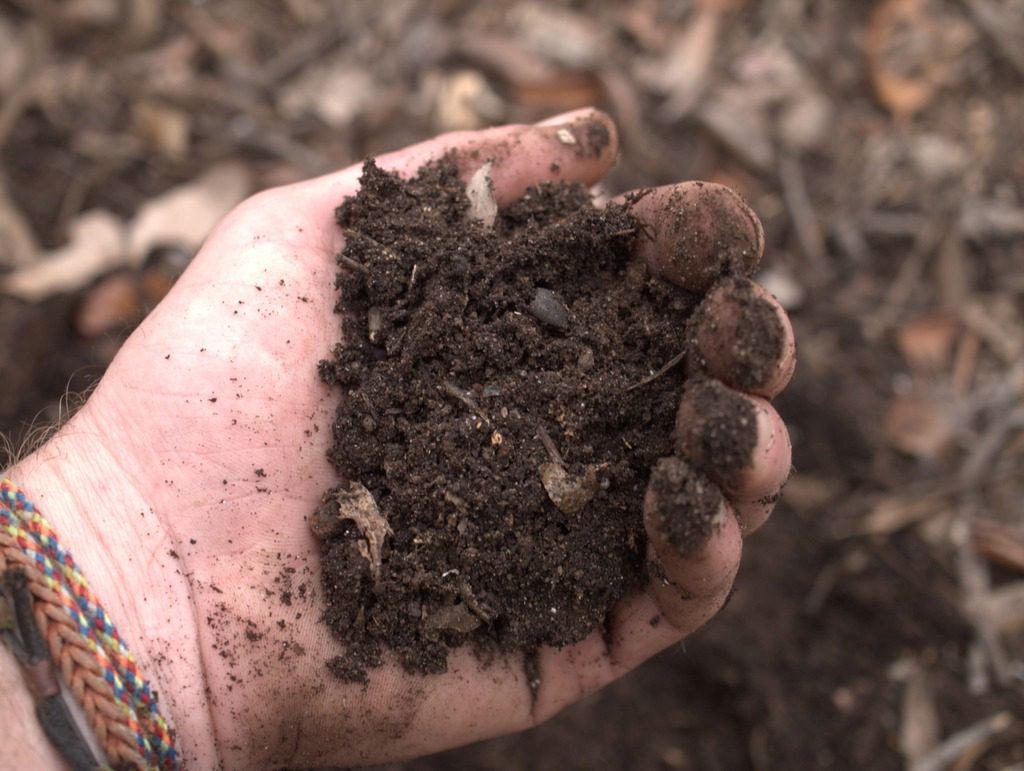
Look at that beautiful dark topsoil that’s had mulch and leaves decomposing on it for years. It’s crumbly yet moist. Photo via Plants Grow Here.
Organic material truly is integral to soil structure. Read my article on a few of the different organic fertiliser options out there and why they are better for the soil than artificial fertilisers here.
A good soil structure will have plenty of pores and will allow air and water to move freely. Enough water is stored to keep plants satiated without drowning them, and seedlings are able to push up through the surface while roots are able to grow down as deeply as needed.
It’s so easy to negatively impact soil structure, and we do so at our own detriment. Compaction by driving and heavy foot traffic on grass would be one example. Compacted soil doesn’t hold as much water seeing as pores as squished, so obviously plants and other organisms will suffer.
Hand-removing weeds that hold the soil together with their roots is another way to ruin the soil structure. Erosion is likely to occur unless we allow new plants to colonise the spot or cover it with mulch.
Crop Rotation
Many veggies that we eat and love are grown as annuals plants to be replaced every year. Such examples are broccoli, carrots, and peas; we harvest these plants and then grow a new plant next year.
If we plant the same exact plant in the same place each year, while fertilising with the same nutrients and the plant is feasting on its own particular nutritional needs, some consequences start to appear.
There may be an accumulation of certain nutrients that the plant does not need high quantities of, and there may also be a build-up of certain harmful organisms.
Different plants have different effects on the web of life. Brassicas like cabbage reduce levels of fungi, both beneficial and pathogenic. They are also a prime target for nematode pests that are hard to get rid of.
Legumes form relationships with and increase numbers of bacteria in the soil.
When we re-use the material left over by our rotating crops, by composting them or letting them self-mulch on the surface, we are returning the special elements that those particular plant tissues have to offer.
Of course, there are many edible plants that are perennial, such as fruit trees. Some plants, like tomatoes, are grown annually and perennially in different climates.
Landscape
The steepness of the land affects what it can be used for, and also plays a large role in water runoff and erosion; the steeper the slope, the more runoff and the higher the likelihood of erosion. Because of this, soil at the bottom of a hill is usually better, deeper and moister than the soil on the hill itself.
Opposite sides of a hill may have different plant growth happening due to the differences in aspect. In Australia, in the southern hemisphere, northern-facing slopes get a lot more sun than southern-facing slopes. This causes the northern side to be drier and brighter than the southern side.
Vegetation
Trees, shrubs, ground covers, vines, herbs, and weeds are all good indicators of soil health. As their leaves drop and plants die, their bodies form organic fertiliser and humus as they decompose. Their roots also help provide soil structure while they’re alive and they attract other organisms that are also highly beneficial.
The types of plants you have can suggest different soil properties. For example, clovers have an upper hand in soils that are low in nitrogen because they can synthesise their own from the air with the help of beneficial bacteria. If clovers are dominating your lawn, you might have low levels of nitrogen present.
In wet areas, certain plants thrive and others don’t. The right plants can help drain the soil by drinking the water and using some of it, but losing most of it through transpiration, or loss of moisture through their leaves.
Having trees that are known to have deep root systems can be a great sign that you might have a nice soil depth to work with, and these guys can really help hold the soil together on a much larger scale than smaller plants can, even though the small plants are important too.
Crusting
Sometimes a crust or smooth surface forms over the soil, and this is definitely a bad sign.

Dry, cracked clay soil with fine particles and a crusted and cracked top. It doesn’t look like much organic material is in there. Image source
Crusting can be caused by an excess of salt (sodic conditions), erosion, puddling or raindrops falling on poor soil and causing the fine particles to splash. In crusted soils, fine clay and silt particles clog up the pores in the top of the soil, creating a barrier to the soil below. Water and air struggle to get down to the soil below a crust, and seedlings struggle to rise out of this barrier.
The best way to fix a crusting issue is usually going to be tilling some organic fertiliser in, and encouraging more plants like grasses, weeds and plants that you’ve bought to thrive by adding organic fertilisers to the soil.
Some crusts are actually due to a ground-covering layer of bacteria, moss or lichen that have colonised the site instead of a clogged surface. These are naturally-occuring and beautiful in their own way but still indicate poor soil conditions and might call for a similar remedy as normal crusting if you are wanting to grow any plants there.
Slaking Soil
One of the causes for crusting is slaking, which is what happens when weak aggregates (groups of soil particles that stick together) experience heavy rainfall and aren’t able to hold their shape, at which point they break apart and the soil completely loses its structure.
In slaking crusted soils the smaller particles fill in all of the gaps in the soil and harden after drying.
You can test if your soil is susceptible to slaking by putting a small pea-sized piece of dry soil into a dish with distilled or rain water. If the lump holds its structure, that means you’ve got plenty of organic matter to hold it all together like glue. You’ve got healthy soil.
If the soil starts disintegrating before your eyes instead of holding its shape, it’s slaking. Slaking soil will also release bubbles.
If the soil holds its form for a while but after a while (say, 30 minutes) it starts clouding the water, you have dispersing soil which is another cause of soil crusting.
Dispersing Soil
If there’s an excess of sodium, the soil particles move apart and you get dispersing soil, which leads to poor soil structure.
Sodium (salt) attaches to clay particles, and when water is added into the mix, the sodium attracts water between each of the particles, destroying the soil structure.
Salty (sodic), dispersing soil can be amended with gypsum.
Waterlogged Soil
Saturated or waterlogged soil may be a drainage issue or may be due to a high water table. Neither issue is ideal, but start hoping that it’s not a high water table
It’s possible to test how deep the water is saturated with a long rod, which you can push down into the earth and get a feel for waterlogging. You can also test for soil compaction in this way.
Poor drainage may be amended with organic fertilisers and perhaps even a bit of clay breaker like gypsum to get drainage in heavy clay soils going. There are several forms of soil drainage systems that you can use, where water is physically drained and removed.
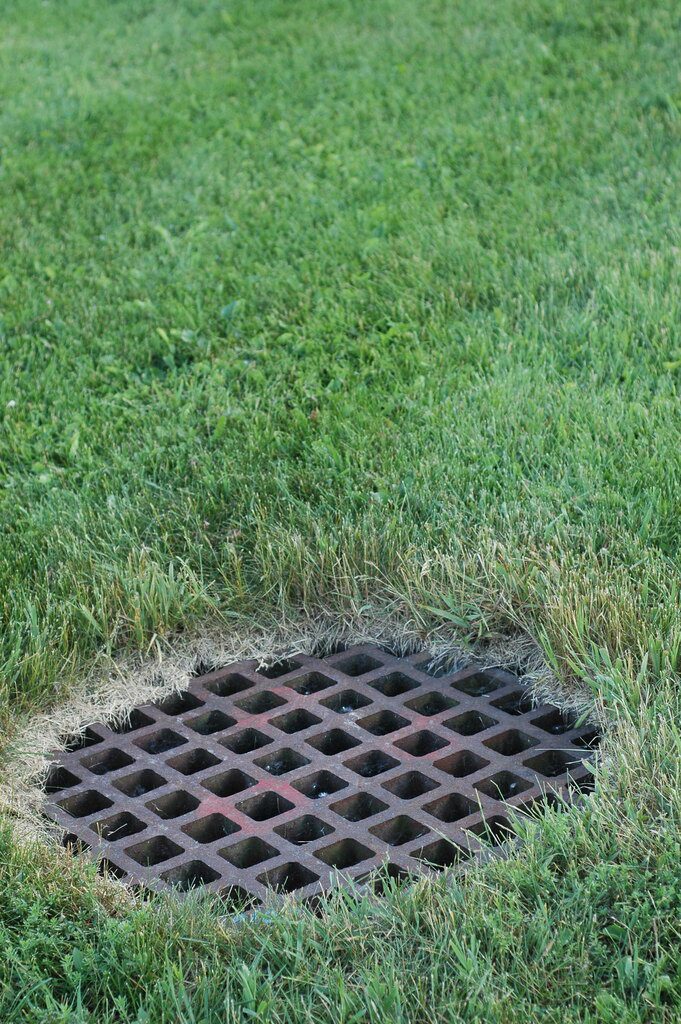
Physical water drainage. Image source
With that being said, it might be best not to fight too hard against nature; if the garden’s on a riverbank, maybe just plant the right plant in the right place, or leave the land alone and see what pops up naturally.
Erosion
The movement of soil from one place to another is called erosion. It’s a natural part of life that’s always taken place throughout time, however generally as gardeners and horticulturalists we like to avoid causing it.
Erosion is usually caused by one of the three following factors: water, wind and gravity. However, there’s usually an underlying soil health problem there to start with because healthy soil is less likely to erode than poor soil.
The topsoil is often more sturdy than the subsoil beneath, and simply disrupting the topsoil, like driving a car over it or tilling it, can be enough to get a gully started that the rain, wind and gravity will make larger and larger over time.
Keep an eye out for “rills”, or small channels that water runoff has created. Without addressing problems like this early on, you can be sure erosion will get much worse over time.
Prevention of erosion is done by ensuring the soil has plenty of organic material in it, minimal tilling, and providing a variety of plants. If ground covering plants like grasses aren’t used, a thick layer of mulch will help.
Alluvial Soil
The valuable topsoil that is washed away by the rain, blown away by the wind, of dumped off the top of a mountain is delivered to a new area is called “alluvial” soil. Adding more topsoil is usually a huge advantage when it comes to growing plants, so if you’ve got alluvial soil on your property you’re very lucky!
If it’s blown over aquatic environments it has been reported to cause a spike in phytoplankton which can cause damage to the food web with harmful algal blooms, so not only can erosion cause you to lose your best soil, but it can also cause ecological damage.
Colour
Soil colours can mean different things.
Dark soil is usually associated with having a lot of organic material in it, whether that’s fresh compost or from long ago in the soil’s history. Dark colouring may also come from the parent rock and have nothing to do with organic content at all.
Red soil may indicate high levels of iron. Volcanic red soil is some of the best soil to start with because it’s jam-packed full of other minerals too, which soil microbes love especially when there’s a lot of organic material in there too.
Light-coloured soil is usually very low in organic material and nutrients and so are low in fertility; you want dark brown or red soil, ideally. Don’t buy a farm with white soil!
Mottled soil colour may indicate periodic waterlogging.
There can be quite a difference in colour between dry soil and wet soil, so keep that in mind, and also don’t forget that there may be many layers of soil beneath what you see.
What Is Soil pH, & What Are Its Effects?
Soil pH is measured from 1 (most acidic) to 14 (most alkaline), however most plants are only able to exist within a soil reading of 5.5 to 8, with individual plant species each having their own preferences within that spectrum. Water has a reading of around 7, which is considered neutral.
Plants that come from sandy environments naturally tend to prefer acidic soil, and plants from clay-dominant soils tend to prefer alkaline soil.
The effects of pH on plants is very complicated, and changes can disrupt the entire soil ecosystem. Most of our living friends in the soil prefer the same conditions that our plants prefer: about 5.5-8, which isn’t too extreme on either end. And they can be even more sensitive to changes than our plants.
The bioavailability of elements can also be affected by the acidity level in the soil. For example, most plants don’t love a lot of aluminium, but this element is released when the soil is overly acidic. Even if the plant can physically withstand the level of acidity, it may be poisoned by the level of aluminium.
Other beneficial nutrients are held from plants with changes in pH, so our plants can just as easily be starved of desirable nutrients as they can be poisoned by undesirable elements. They are showing signs of a nutrient deficiency, but fertiliser isn’t helping because the nutrients are not available for the plants.
What Causes Soil pH?
A lot of the time, the acidity levels of soil are created, or at least influenced, by the parent rock deep in the soil. Some parent rocks are more acidic, and others are more alkaline.
However, other factors definitely do play into soil acidity, such as certain farming practices and the types of organisms present.
Fertilisers that are high in nitrogen (including organic fertilisers) are notorious for making soils more acidic. When nitrogen in the form of nitrate leaches into the soil, it’s no longer bioavailable for plants to consume but instead lowers the pH to make the soil more acidic.
Changing The pH
If you think that your soil may have a pH issue, consider testing it with a home test, or having it professionally tested through a soil lab before you attempt any changes.
Home testing is easy enough; test kits come with helpful instructions and guides to help you make a positive identification and are really quite accurate.
Alternatively, some moisture meters come with a pH reader, however I personally would use the moisture meter’s pH reading with a grain of salt unless I had checked its reading against a home test kit to make sure it’s calibrated correctly.
Be very careful when trying to change the pH on your land. It’s easy enough to make minor changes if you’re careful, but drastic changes can cause problems especially if you go too far too quickly. Just know that your efforts will probably have to be repeated over time, because the land will want to take your pH back to where it wants it.
The more information you have about your soil the better, so you may want to check multiple locations and multiple depths. You want to calculate the right amounts of amendments for each area on the land you’re improving.
Elemental sulphur, aluminium sulphate, acidifying nitrogen and organic fertilisers all help lower the pH, so can be used to make alkaline soils more acidic.
Usually lime (as in limestone, not the citrus fruit) is used to raise the pH, or make acidic soils more alkaline. It’s much more common to encounter highly acidic soils than alkaline ones, so it’s more likely that we would need lime than elemental sulphur.
Clay soils have a greater “buffering capacity” than sandy soils when it comes to changing the pH, meaning that clay soils are able to absorb lime without as much of an effect as dandy soils. Because of this, we need to add more lime to clay soils when trying to acidify them.
Always follow the instructions on the product label and seek professional advice where possible.
Hydrophobic Soil
With hydrophobic soil, no matter how much you water your garden, your plants still look thirsty. Water is running down the gutter, and you simply can’t seem to get the moisture past the soil surface even though the soil is loose and sandy. It seems that you’ve got hydrophobic soil on your hands.
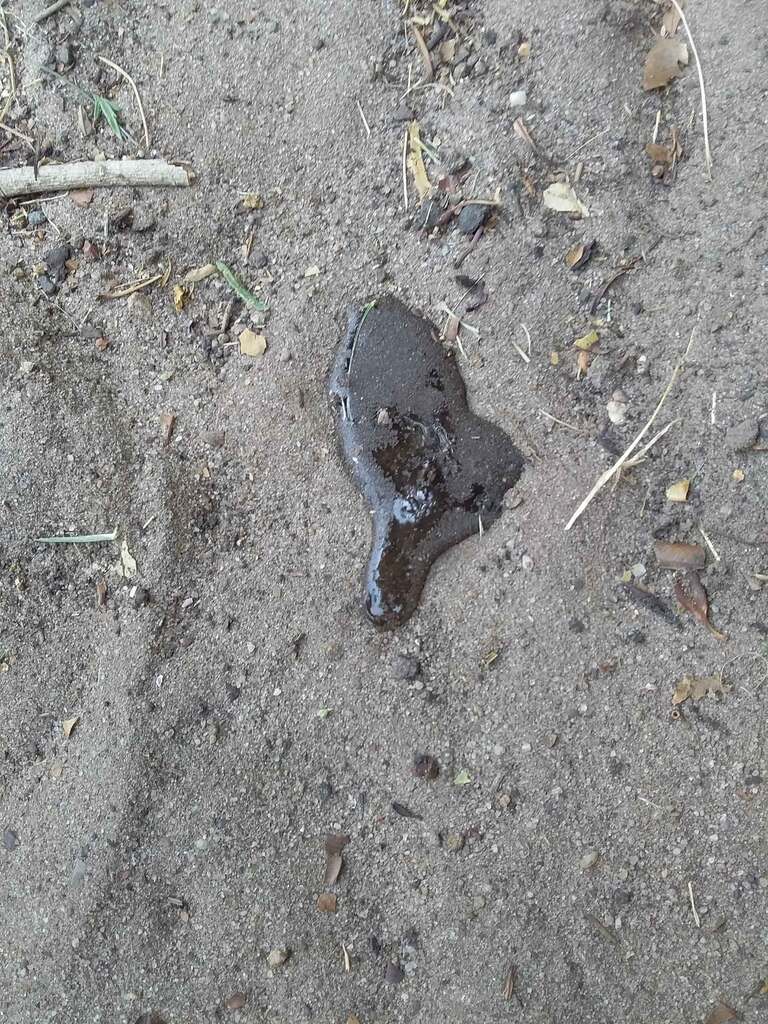
Water sits on top of hydrophobic soil and doesn’t soak into the soil easily. Photo via Plants Grow Here.
Maybe it was caused by the un-composted organic matter that accumulated on the top of the earth and left a waxy residue. Maybe the area has experienced a wildfire recently. Or maybe it was because the soil was dry for so long that it just died. In any case, using soil wetters alone will not fix the problem for long.
What’s happening in this case is that the soil particles have a waxy or oily coating which is preventing the water from getting through. Soil wetters work like a detergent to loosen the oily coating, however this is a band-aid solution which won’t help long term. Just like all chemicals they can also kill microbes which are essential to healthy soil, all without even preventing the soil from becoming hydrophobic again later in the year.
What you really want to do is feed your soil with some compost (or another organic fertiliser), which will immediately make a difference because compost can help with aeration, water infiltration, water retention and structure. It’s also full of microbes that can work on breaking down the waxy oil to improve the old soil.
While you’re at it, you may as well add in some activated biochar as well, which is even better at absorbing and holding water and has a very impressive nutrition content to feed your plants, not to mention is regarded as being incredibly environmentally friendly due to its capacity to hold carbon in the soil for potentially thousands of years.
Immediately after tilling the compost (and potentially biochar as well) into the soil, water is more readily accepted and the problem will heal over time. Consider adopting a no-till method from there and applying organic fertilisers from the top as nature intended.
Compacted Soil
Compacted soil is more likely to happen with clay-dominant soil than with sandy or silty soil, however any soil can become compacted.
Similar to hydrophobic soil, you can water all day long and most of it will simply roll into the gutter because it isn’t able to penetrate the compacted soil.
Plants growing in compacted clay are in a similar predicament to if they were growing inside a brick wall. It’s incredibly hard for their roots to penetrate in order to grow, and they also struggle to breathe.
Soil compaction is commonly caused by mechanical pressure, for example farming cloven-hoofed animals like sheep and cattle, driving vehicles over the ground, or having a lot of foot traffic over the area. However, it can also happen naturally via a process of regular drying and wetting, called “soil consolidation”.
It’s much easier to prevent compaction than to remedy it. If driving or large amounts of foot traffic over the soil are absolutely necessary, try to use the same tracks so that you have deeply compacted areas where the wheels (or feet) travel which will provide traction, while leaving the other parts of the land unaffected.
A clay-breaking liquid gypsum mixture may be required to initially loosen compacted clay soil, and once it’s easily tillable compost and biochar can be added to improve the overall soil health and encourage its ability allow the movement of water.
Bad Soil Signs
You can often spot poor soil before you even dig into the earth.
How much of the soil is covered by plant life? If it’s a bare patch of land without even a single weed, it’s probably a pretty poor piece of dirt.
How are the plants that are on the site looking; are they vibrant and healthy, or are they slow-growing and sickly? If there is a lot of stubble, which is dead plant material still attached in the ground, this might be a sign that the soil has become so bad it can no longer support the plants that had existed there.
If the soil has a foul smell, that’s a pretty bad sign; you want it to smell “earthy”. Any signs of slaking, erosion, crusting, waterlogging, compaction, lack of colour, or open patches of uncovered dirt are also very bad omens.
Fixing Unhealthy Soil
Tips on fixing unhealthy soil have been sprinkled throughout this whole article, but the main tips are to ensure that the soil has plenty of organic material, drainage, the right pH, and a lack of activity that promotes compaction. Gypsum can be used on sodic or heavy clay soils.
Maintaining Healthy Soil
So you have healthy soil and now you’re just in maintenance mode. What now?
For starters, try to leave the soil alone for the most part, except for adding compost to the top of the soil regularly. We might want to think about avoiding tilling healthy soil as it disrupts the party that’s going on beneath our feet. With that being said, don’t stress too hard if you’re cultivating veggies by tilling, as long as you’re adding lots of organic matter to keep the soil structure and health up it should be fine.
We want to replace the nutrients that we take away in the form of grass clippings, hedge trimmings, flowers and fruits that the plants have created using nutrients they’ve acquired from the soil.
Why not make a compost pile of your own and put your kitchen scraps to use as well as your garden waste. Save the money you were going to spend on organic fertilisers!
You can simply top dress your soil with organic fertilisers, which means lightly scatter them over the soil or grass. Obviously use your best judgement; don’t simply throw compost or manure on top of the seaside daisies as this will look ugly. Instead, lift the foliage up and place the compost beneath, out of sight. Mulch can be raked off the soil so that compost can be applied, then raked back over again.
If you’re after a good top dressing option, something like Dynamic Lifter is awesome because it’s an organic fertiliser blend that comes in pellets that you can easily spread.
Avoid leaving bare patches of soil. If you don’t want to cover it with a ground covering plant, you can use a nice thick layer of mulch instead to help keep the moisture within the soil.
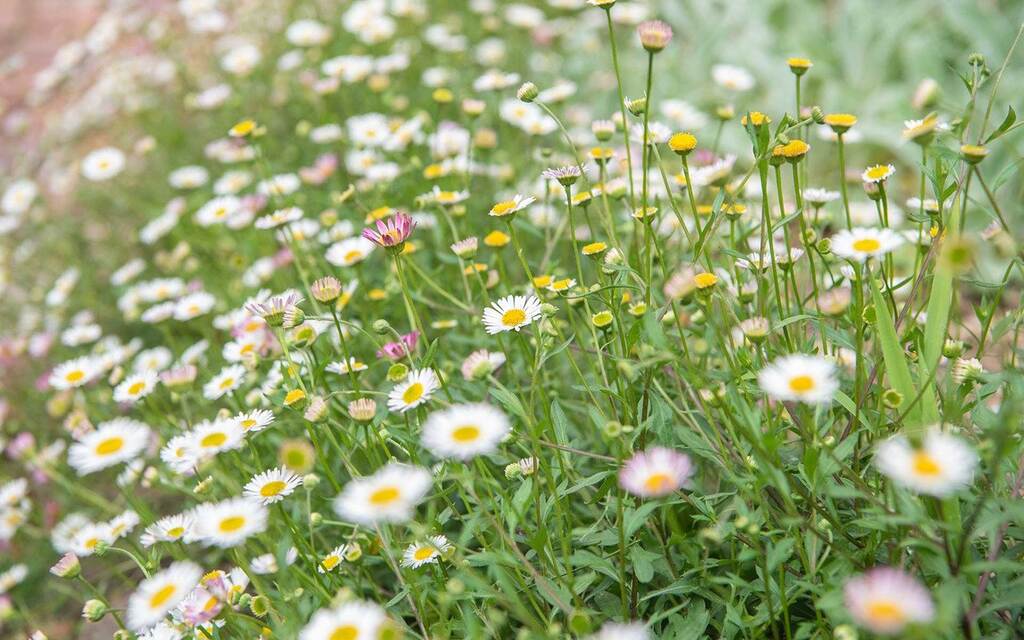
Seaside daisy provides a great ground cover for soil. Photo via Plants Grow Here
Conclusion
Civilisations thrive and fall by their soil. Those that don’t take care of it are severely weakened compared with those that have firm (but soft) ground beneath their feet.
Healthy soil, teeming with life and with complex chemistry, is able to withstand some abuse, and even bounce back if damage is done to it. This ability is known as resilience.
If you aren’t taking notice of the soil in your garden, chances are you’re really shooting yourself in the foot as a gardener. All of the money in the world spent on other plant health factors won’t help your plants unless their soil is able to fulfil their basic needs.
Feed the soil, and the soil feeds the plants!
Where To From Here?
That was a lot of info, huh? Good on you for making it this far!
If you still aren’t done learning yet, or you’d like to save a couple of lessons for next time, I recommend starting by reading more about beneficial underground organisms and how they improve soil health and structure.
Alternatively, you can learn about plant health problems including questions to ask about a health problem, and Integrated Pest Management (IPM).
Knowing some plant biology basics can make you a better gardener because you understand a little bit about what’s going on “under the hood”.
